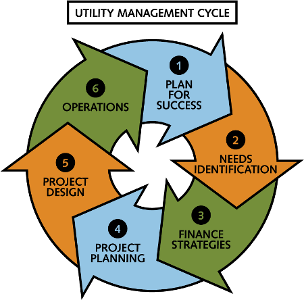Resources by Category
-
Consolidation Feasibility
Many operational and economic benefits are realized by water systems when they consolidate. Most public water systems applying for construction funding or a refinancing loan must perform an evaluation, including costs and feasibility, of consolidating with another public water system.
This resource includes overview information on water partnerships, which can take many forms, including: local resource sharing, physical consolidation, managerial consolidation, and full regionalization.
https://www.waterboards.ca.gov/drinking_water/certlic/drinkingwater/waterpartnership.html
-
System Description
Water systems without any existing maps can use several approaches to create rudimentary maps using inexpensive PC-based software (i.e. google earth). As-built drawings can also be created from copies of maps obtained from city and county planning and zoning agencies, and the Local Agency Formation Commission (LAFCo) which can be modified to include water system elements. For small utilities, copies of the original subdivision map or Assessor’s parcel maps can be the basis for creating system maps.
-
Certified Operators
The State of California requires that all public water systems with water treatment facilities have certified water treatment operators. These systems can meet the operator certification requirements with a certified distribution operator. All community and non-transient non-community public water systems with or without water treatment facilities must have certified distribution operators.
Link to State Water Resource Control Board’s Office of Operator Certification https://www.waterboards.ca.gov/water_issues/programs/operator_certification/
-
Source Capacity
An adequate source of supply is determined by quantifying water system demand, supply and the capacity of the physical plant to deliver water. Because developing additional water supplies requires time and capital expense, long-term planning is essential to obtaining water supply in a timely manner.
The State Water Resource Control Board’s Groundwater Program resource provides links to the SWRCB’s resources related to managing the state’s groundwater resources.
https://www.waterboards.ca.gov/water_issues/programs/groundwater/
See also:
-
Operations Plans
Operations plans should be individually tailored to each water systems size, source water, treatment, water quality, distribution system and available resources. The Operations Plan should provide a complete and accurate view of the water system’s operation.
-
Training
Water treatment and distribution system operators require continuing education to maintain their certifications. The amount of training required is based on the operator’s level of certification.
-
Ownership
The Water System Ownership must be clearly identified for all components of the water system as part of the TMF Assessment. If your system does not have copies of ownership documentation, the County may have copies, or contact your attorney.
-
Water Rights
Water rights are a specialized area of law and can be very complex. Water systems should obtain specific water rights information from the State Water Resources Control Board website at http://www.waterboards.ca.gov/waterrights/ or seek experienced legal counsel if necessary. See also:
-
Organization
The water system’s organizational structure should be designed to support its operational, financial and regulatory objectives and mission. Organizational structure provides the foundation for information flow, managerial control of work processes and accountability within the organization.
-
Emergency/Disaster Response Plans
The Public Health Security and Bioterrorism Preparedness and Response Act of 2002 requires all public water systems, serving a population greater than 3000, to certify the completion of an Emergency Response Plan to the United States Environmental Protection Agency (USEPA) by December 30, 2004. The resources below have documents to help develop Emergency Response Plans.
-
Policies
A policy manual describes procedures pertinent to the management of the water system. There are many activities important to the orderly and business-like operation of a water system. Failure to perform these activities in a consistent and prescribed manner can lead to problems, both internal and external, to the organization. Well-managed and operated systems have comprehensive written policies that address all aspects of water system operation. Formal published organizational policies assure that all parties are aware of the activities and standard expected for that utility.
-
Budget Projection and Capital Improvement Plans
The budget projection is the most important element for demonstrating financial capacity. It functions as both a plan for the water system’s financial future and a tool for actively managing current operations. An accurate budget projection relies on information developed in an Asset Management Plan and Capital Improvement Plan.
-
Budget Control
Maintaining fiscal viability is a primary responsibility of the water system’s governing body (e.g., board of directors, city council, sole proprietor). Once a budget projection is developed and approved by the governing body, it is their ongoing duty to monitor the system’s financial performance. This is accomplished by reviewing a monthly comparison of the budget projection against the system’s actual financial performance.



